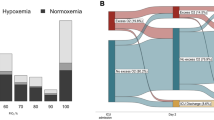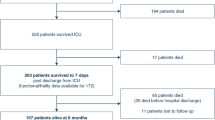Abstract
Purpose
End-of-life care characteristics and palliative care (PC) utilization of elderly acute myeloid leukemia (AML) patients have rarely been reported. The aim of this study was to evaluate the cause of death, place of death and PC utilization of older adults (age 60 years or above) suffering from AML.
Methods
Patients were recruited retrospectively from two hematology units in Hong Kong, which consisted of one university department with Bone Marrow Transplant service, and one regional hospital with hematology specialty service. Collaboration with PC unit was established. Elderly AML patients referred to PC service were included. Medical records of all identified patients would be reviewed retrospectively by two PC physicians.
Results
From October 2011 to April 2013, 156 hematological cancer patients were referred for PC; 43 elderly AML patients were included into data analysis. The median time from AML diagnosis to death was 9.1 months. Up to 46.5 % patients received supportive care alone since diagnosis. More than half of elderly AML patients died in acute ward and hematology units (53.5 %), while 30.2 % died in PC settings. Overall, 51.2 % of patients spent the whole period of their final month of life in-hospital. Infection-related diagnoses contributed to 51.2 % of deaths. Median time from AML diagnosis to first PC consultation was 1.0 month. PC service includes psychosocial support (100 %), hospice in-patient care (30.2 %), homecare (60.5 %), PC outpatient clinic (14.0 %) and bereavement care (93.0 %).
Conclusions
Elderly AML patients carry dismal prognosis with their final phase of disease mostly hospitalized in acute care settings. Infections and bleeding could complicate course of illness and lead to rapid deterioration. PC collaboration remains important in psychosocial support and coverage of dying AML patients in non-hospice settings.
Similar content being viewed by others
References
Klepin HD, Balducci L (2009) Acute myelogenous leukemia in older adults. Oncologist 14:222–232
Estey E (2007) Acute myeloid leukemia and myelodysplastic syndromes in older patients. J Clin Oncol 25:1908–1915
Pollyea DA, Kohrt HE, Medeiros BC (2011) Acute myeloid leukaemia in the elderly: a review. Br J Haematol 152:524–542
Manitta VJ, Philip JA, Cole-Sinclair MF (2010) Palliative care and the hemato-oncological patient: can we live together? a review of the literature. J Palliat Med 13(8):1021–1025
Corbett CL, Johnstone M, Trauer JM, Spruyt O (2013) Palliative care and hematological malignancies: increased referrals at a comprehensive cancer centre. J Palliat Med 16(5):537–541
Bauder F, Capdupuy C, Renoux M (2000) Characteristics of deaths in a department of oncohaematology from a general hospital: a study of 81 cases. Support Care Cancer 8(4):302–306
Cheng BHW, Sham MMK, Chan KY, Li CW, Au HY (2013) Intensive palliative care for patients with hematological cancer dying in hospice: analysis of the level of medical care in the final week of life. Am J Hosp Palliat Care
Ferrara F, Schiffer CA (2013) Acute myeloid leukaemia in adults. Lancet 381(9865):484–495
O'Donnell MR, Abboud CN, Altman J et al (2012) Acute myeloid leukemia. J Natl Compr Cancer Netw 10(8):984–1021
Tilly H, Castaigne S, Bordessoule D et al (1990) Low dose cytarabine versus intensive chemotherapy in the treatment of acute nonlymphocytic leukemia in the elderly. J Clin Oncol 8:272–279
Nosari A, Barberis M, Landonio G et al (1991) Infections in haematologic neoplasms: autopsy findings. Haematologica 76(2):135–140
White PH, Kuhlenschmidt HL, Vancura BG, Navari RM (2003) Antimicrobial use in patients with advanced cancer receiving hospice care. J Pain Symptom Manag 25(5):438–443
Benjamin Cheng HW, Sham MK, Chan KY (2014) Emergence of vancomycin-resistant enterococci in the palliative care setting—how to strike the right balance in infection control measures? J Pain Symptom Manag 47(1):e7–e8
Maddocks I, Bentley L, Sheedy J (1994) Quality of life in patients dying from haematological diseases. Ann Acad Med 23:244–248
McGrath P, Holewa H (2007) Special considerations for haematology patients in relation to end-of-life care: Australian findings. Eur J Cancer Care 16(2):164–171
Rodin G, Yuen D, Mischitelle A et al (2013) Traumatic stress in acute leukemia. Psychooncology 22(2):299–307
Sekeres MA, Stone RM, Zahrieh D et al (2004) Decision making and quality of life in older adults with AML or advanced MDS. Leukemia 18:809–816
Quill TE, Abernethy AP (2013) Generalist plus specialist palliative care—creating a more sustainable model. N Engl J Med 368(13):1173–1175
Temel JS, Greer JA, Muzikansky A et al (2010) Early palliative care for patients with metastatic non-small-cell lung cancer. N Engl J Med 363:733–742
Zimmermann C, Yuen D, Mischitelle A et al (2013) Symptom burden and supportive care in patients with acute leukemia. Leuk Res 37(7):731–736
Cheng HW, Li CW, Chan KY et al (2014) Bringing palliative care into geriatrics in a Chinese culture society—results of a collaborative model between palliative medicine and geriatrics unit in Hong Kong. J Am Geriatr Soc 62(4):779–781
Chan KY, Cheng HW, Yap D et al (2014) Intensified renal palliative clinic follow-up may reduce acute hospital admission and improve clinic attendance: Hong Kong experience. J Pain Symptom Manag. doi:10.1016/j.jpainsymman.2014.04.010
Acknowledgments
The authors acknowledge Professor Albert Lie, Professor Y.L. Kwong and Professor Y.H. Leung, as well as all medical and nursing staff of Hematology Unit, Queen Mary Hospital, University of Hong Kong, for their support and advice on the management of hematology patients under palliative care.
Conflict of interest
None.
Author information
Authors and Affiliations
Corresponding author
Rights and permissions
About this article
Cite this article
Cheng, HW.B., Li, CW., Chan, KY. et al. End-of-life characteristics and palliative care provision for elderly patients suffering from acute myeloid leukemia. Support Care Cancer 23, 111–116 (2015). https://doi.org/10.1007/s00520-014-2333-x
Received:
Accepted:
Published:
Issue Date:
DOI: https://doi.org/10.1007/s00520-014-2333-x




